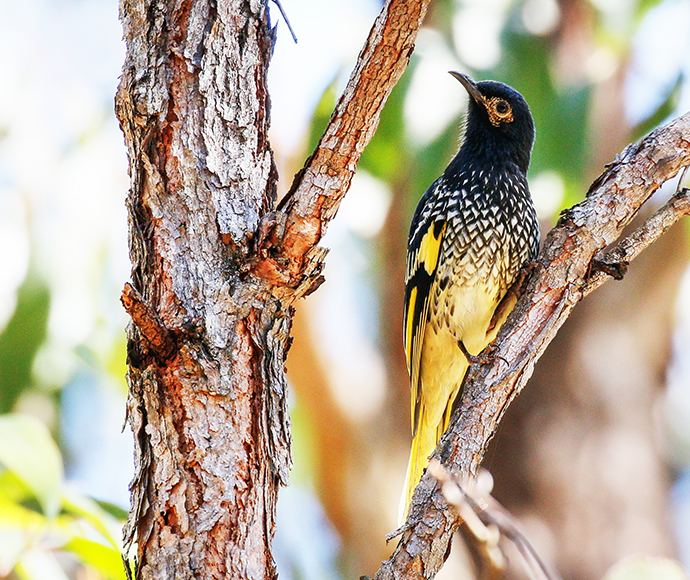Release of zoo-bred birds boosts critically endangered Regent Honeyeater numbers
In a significant step towards the conservation of one of Australia’s most critically endangered birds, 49 zoo-bred Regent Honeyeaters have been released into the wild on Wonnarua country in the lower Hunter Valley.
Regent Honeyeaters are a unique species of songbird found only in south-eastern Australia and are known for their striking black-and-yellow ‘embroidery’ markings. Once abundant from Queensland to South Australia, their numbers have dwindled to just 250 to 300 birds in the wild.
The 2024 NSW Regent Honeyeater release is the third large-scale release on Mindaribba Local Aboriginal Land Council land, and the fifth release state-wide, as part of a national effort to save the species.
The latest release on Wonnarua Country involved the Mindaribba Local Aboriginal Land Council, Taronga Conservation Society Australia, BirdLife Australia and Local Land Services.
This work is led by the NSW Government’s Saving our Species program which has provided more than $1 million as part of the National Regent Honeyeater Recovery Plan, with additional support from NSW National Parks and Wildlife Service and the Australian National University.
More than 200 zoo-bred Regent Honeyeaters have now been released in NSW.
Members of the public can contribute to ongoing efforts to track the survival and movements of the Regent Honeyeater by reporting sightings to BirdLife Australia.
Quote attributable to Minister for the Environment Penny Sharpe
“This latest release of nearly 50 Regent Honeyeaters bred at Taronga Zoo is an exciting step forward in the NSW Government’s plan to save this critically endangered species.
“NSW is home to creatures and plants that live nowhere else on this planet. The Minns Labor Government is taking action to ensure they exist here, for generations and centuries to come.
"I’d like to thank the Mindaribba Local Aboriginal Land Council, who have generously made their land available for the third time, helping us give this beautiful bird every chance of survival.”
Quote attributable to Mindaribba Local Aboriginal Land Council CEO Tara Dever
“The time to start protecting the Regent Honeyeater is now. Its protection starts with every man, woman and child in Kurri Kurri and beyond understanding that this bird is significant to them. The golden sunlight of their wings reflects the warm beauty of the Tomalpin Woodlands and Kurri Kurri itself.
“My grandparents and their parents before them had flocks of Regents in their backyard at Stanford Merthyr; we want our grandchildren to have them in theirs. The Regent Honeyeater is still here because this place of Kurri Kurri, this salty water place, is a good place, it’s special Country.
“It’s time to let people know how special it is. This piece of Wonnarua Country at the foot of old Tumblebee Mountain is as much a part of everyone who has grown up here as it is of the Regent Honeyeater itself.”
Quote attributable to Taronga Conservation Society Australia Divisional Director Andrew Elphinstone
“For more than 20 years Taronga has been dedicated to Regent Honeyeater conservation, contributing to the hugely successful collaborative breeding program that has welcomed over 1,000 Regent Honeyeaters and released approximately 485 birds into the wild.
“It’s so pleasing to see early results indicating this most recent release is going well. Science drives this program and is demonstrating that these releases are vital for securing a future for this beautiful native species.”
Quote attributable to BirdLife Australia Regent Honeyeater Recovery Coordinator Mick Roderick
“These releases of zoo-bred Regent Honeyeaters are vital to the survival of this uniquely Australian bird – and they are working!
“A number of the released birds have been observed in townships across the Cessnock local government area including Kurri Kurri, Pelaw Main and Kearsley and found feeding in flowering trees such as bottlebrushes (Callistemons) and Spotted Gums.
“Any observations by members of the public would be greatly beneficial to our ongoing efforts to track the survival and movements of our released birds and chicks.”
